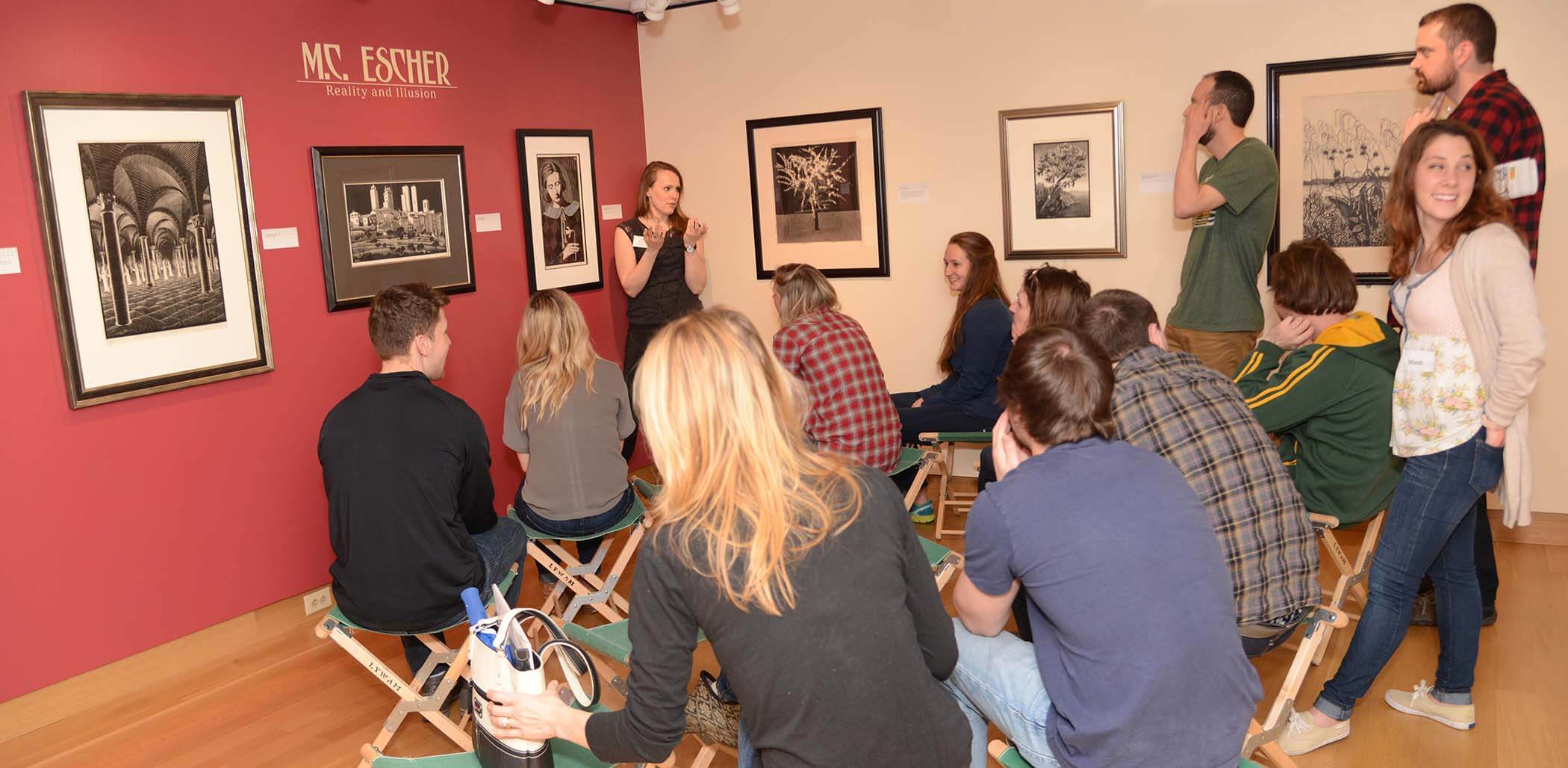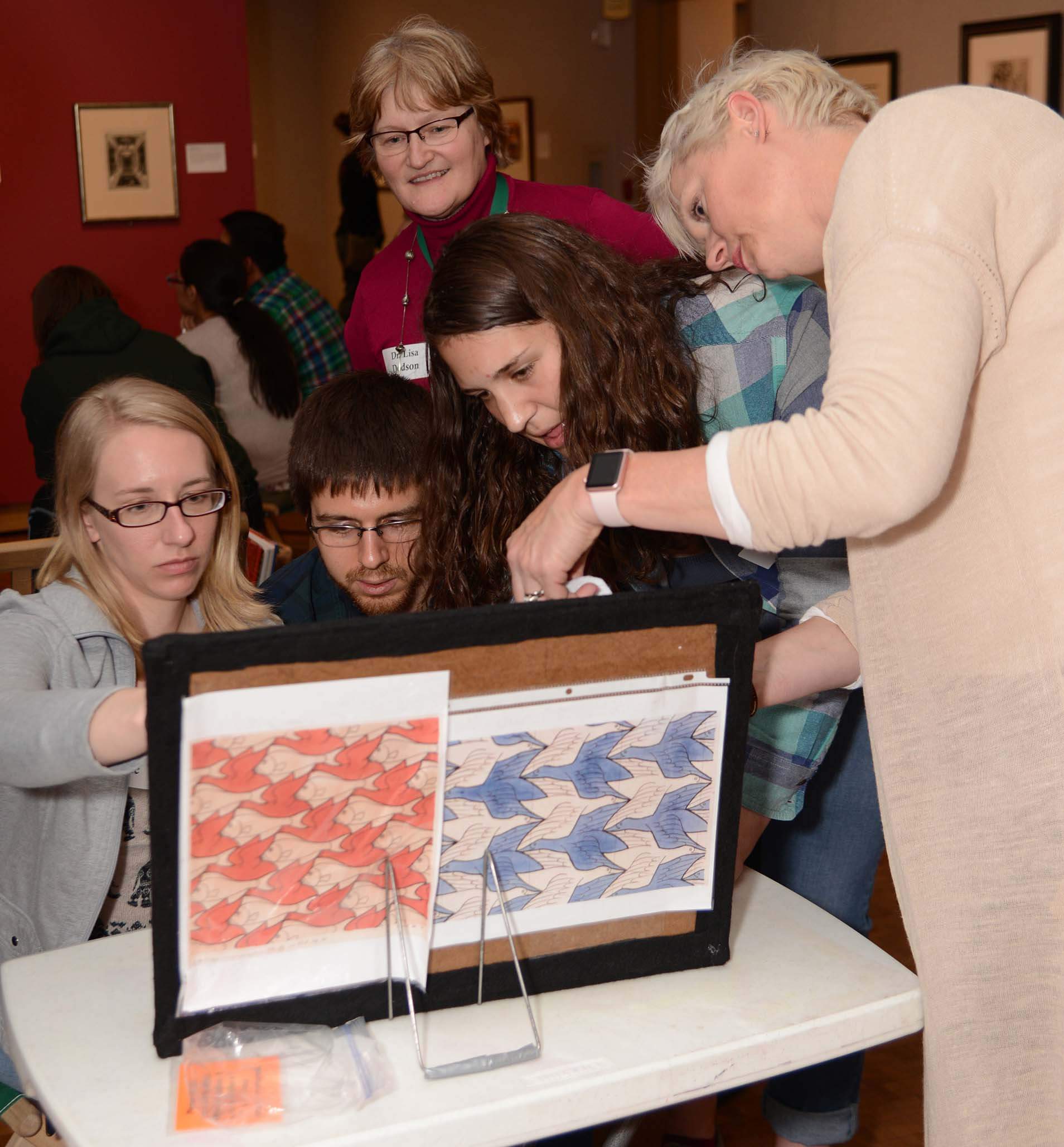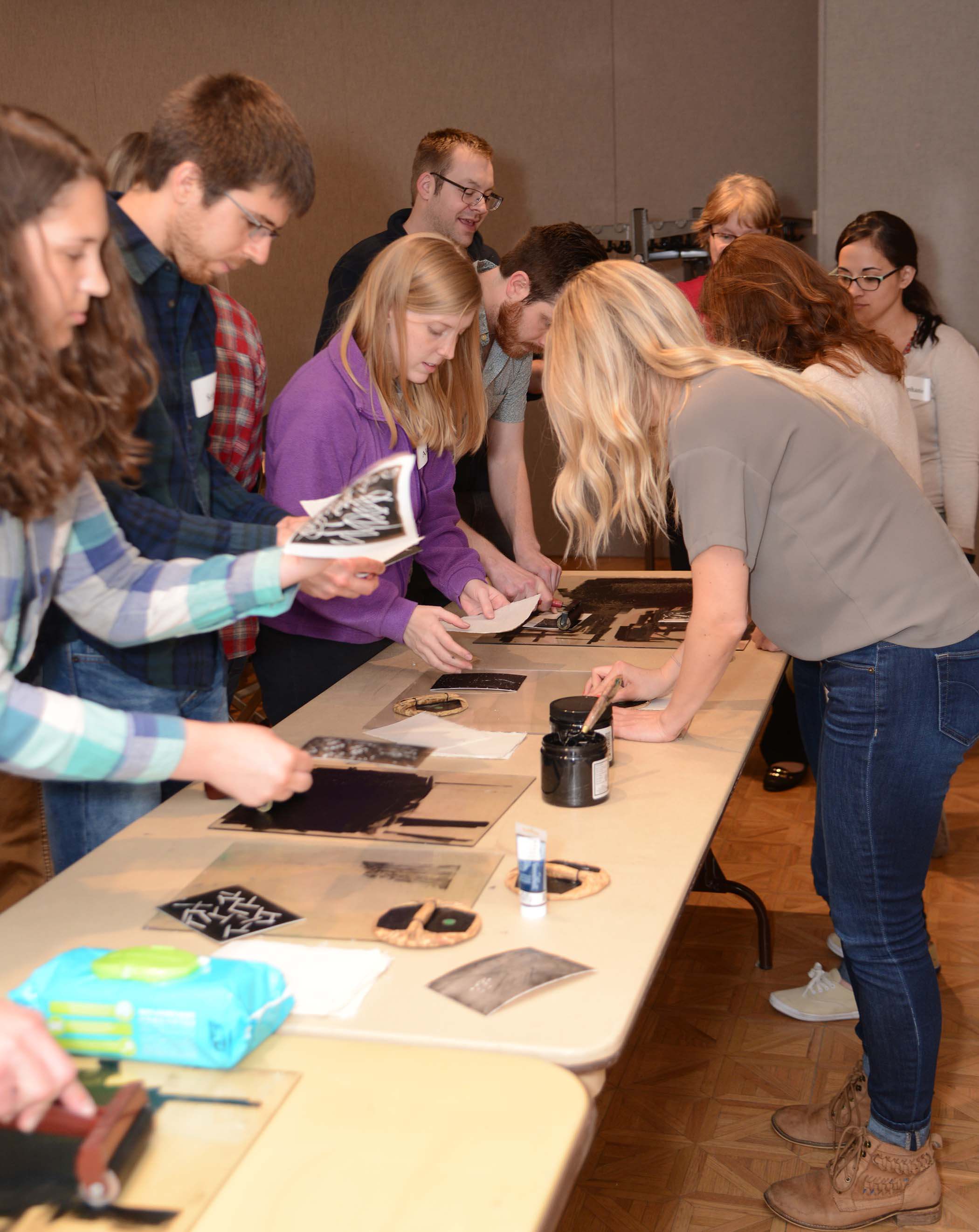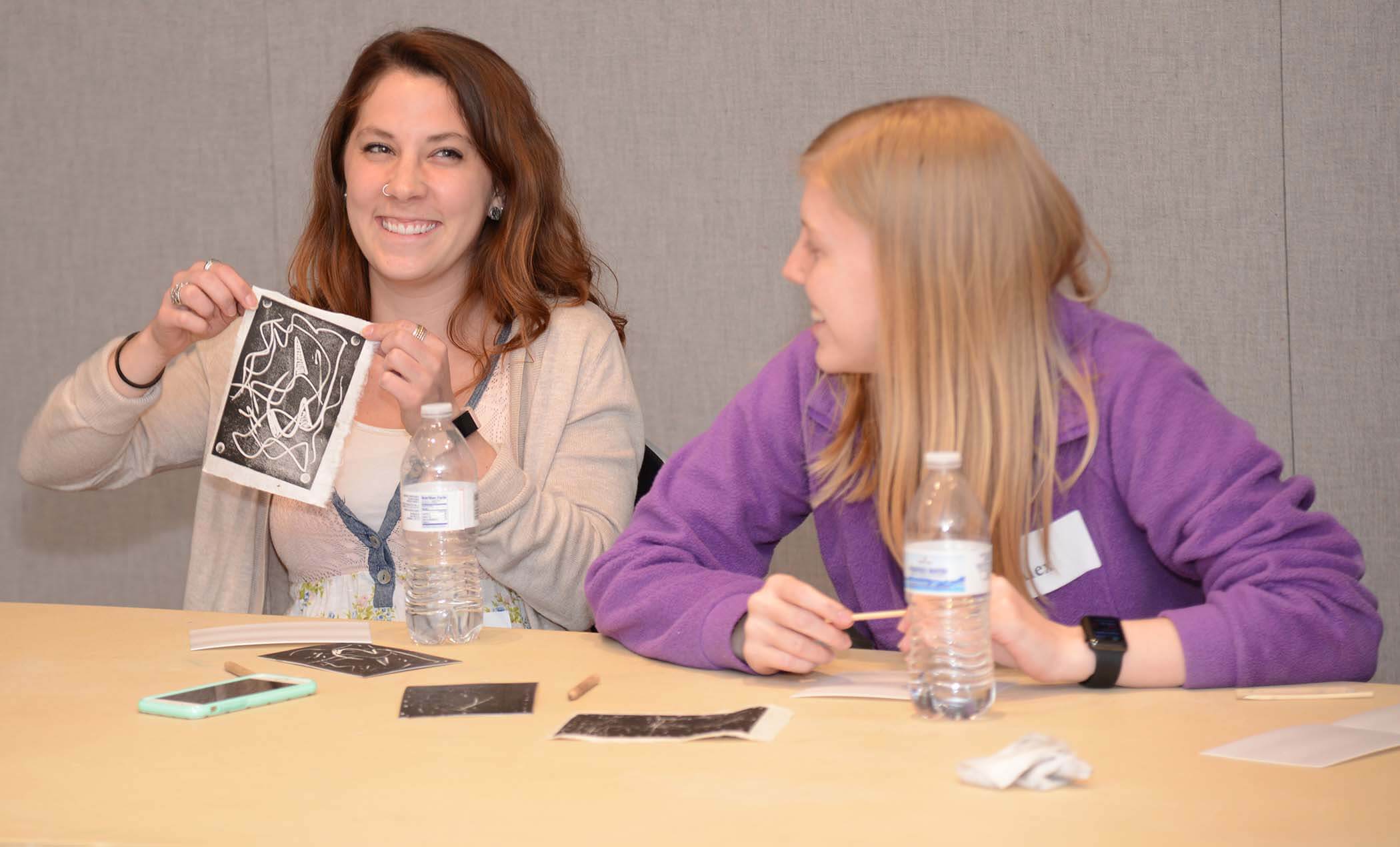 On Thursday, April 20, twenty-five medical students – members of the inaugural class of the Medical College of Wisconsin’s (MCW) Central Wisconsin Campus – visited the Woodson Art Museum with MCW faculty. For several hours that afternoon, students worked with Museum educators to familiarize themselves with the Art Museum, exercise their visual literacy and communication skills, and unwind via hands-on art making.
On Thursday, April 20, twenty-five medical students – members of the inaugural class of the Medical College of Wisconsin’s (MCW) Central Wisconsin Campus – visited the Woodson Art Museum with MCW faculty. For several hours that afternoon, students worked with Museum educators to familiarize themselves with the Art Museum, exercise their visual literacy and communication skills, and unwind via hands-on art making.
The collaboration between the Woodson Art Museum and the Medical College came to fruition after many months of reading, planning, and brainstorming between Museum staff and Medical College faculty as we considered program models, curricular connections, and overarching objectives for the students’ visit.
The group prepared for their visit with readings, which identified successful art museum/medical school partnerships such as the one between Harvard Medical School and the Museum of Fine Arts Boston. If you’re curious, take a look at our pre-visit reading list for the medical students:
New York Times: “What Doctors Can Learn from Looking at Art”
Harvard Magazine: “The Art of Healing”
Greater Good: “Five Ways Museums Can Increase Empathy in the World”
Using artwork on view as a springboard for careful observation and critical thinking, half of the students began in the Audubon to Wyeth galleries with Museum educator Lisa Hoffman while I worked with students in M.C. Escher: Reality and Illusion galleries; then the groups switched, experiencing new artworks and exercises. Implementing Visual Thinking Strategies (VTS) the students and faculty responded to open-ended questions such as “What is happening in this image?” by supporting their answers with empirical evidence found in the artwork.
Working with Lisa, the students tried the “TimeSlips” model of creative storytelling, developed by artist and educator Anne Basting, in Illustrating Illusions: Drawings by Robin Lauersdorf where much conversation and laughter ensued. After working in small groups to create, record, and share their improvised stories based on Lauersdorf’s illustrations, the students explored Art Park, the Art Museum’s interactive family gallery, familiarizing themselves with an engaging community resource for area families.
 No visit to the Woodson Art Museum would be complete without some art making, so we turned classroom space into a relief-printing studio where the group was introduced to low-tech printmaking materials and guided through exercises in “expressive mark making.” I asked the group to imagine a stressful situation, such as coming to class and discovering they’d forgotten a big exam. They channeled their feelings by creating lines and shapes using wooden stylists on foam printing sheets, which were inked, printed, and shared with the group. They inked their foam and printed their results to share with the group. As students held up their prints – visual depictions of their stress – they described the imaginary stressors that prompted their mark making, reflecting on the responsibilities and roles that pull them in many directions daily. When asked about the exercise, students remarked “we need to feel comfortable confronting and talking about our stress” and “it’s therapeutic to make something positive from these feelings and see them in a different way.” The group noted the diversity of the prints, acknowledging that stress manifests itself in many ways and not all signs of stress look the same.
No visit to the Woodson Art Museum would be complete without some art making, so we turned classroom space into a relief-printing studio where the group was introduced to low-tech printmaking materials and guided through exercises in “expressive mark making.” I asked the group to imagine a stressful situation, such as coming to class and discovering they’d forgotten a big exam. They channeled their feelings by creating lines and shapes using wooden stylists on foam printing sheets, which were inked, printed, and shared with the group. They inked their foam and printed their results to share with the group. As students held up their prints – visual depictions of their stress – they described the imaginary stressors that prompted their mark making, reflecting on the responsibilities and roles that pull them in many directions daily. When asked about the exercise, students remarked “we need to feel comfortable confronting and talking about our stress” and “it’s therapeutic to make something positive from these feelings and see them in a different way.” The group noted the diversity of the prints, acknowledging that stress manifests itself in many ways and not all signs of stress look the same.
Each student then created a design to print multiple times. Printmaking has both challenges and benefits – the ability to produce multiple original artworks from a design is a clear benefit, but controlling the variables inherent in the printing process is often difficult or impossible. Printmakers typically embrace the unexpected flaws as happy accidents and experiment with the process to create dynamic original works. Medical students striving for accuracy and perfection could ultimately accept the value of their prints, regardless of how different each turned out.
We wrapped up the afternoon with a conversation about the visit to the Woodson Art Museum, addressing what felt most useful, intriguing, extraneous, enjoyable, etc. . . . Dr. Lisa Dodson, who led the charge for the Medical College to work with the Woodson Art Museum on the pilot program, asked the students to consider how future visits could support their classroom learning as well as their personal well-being as students and engaged community members.
It was a memorable afternoon and an important first step for our respective organizations as we pursue ideas for additional collaborations. Thanks to the students for their willingness to participate and their great attitudes throughout the experience. Thanks, too, to the Medical College of Wisconsin faculty and staff for taking advantage of the Woodson Art Museum’s invitation to host students and share in experiential learning.




